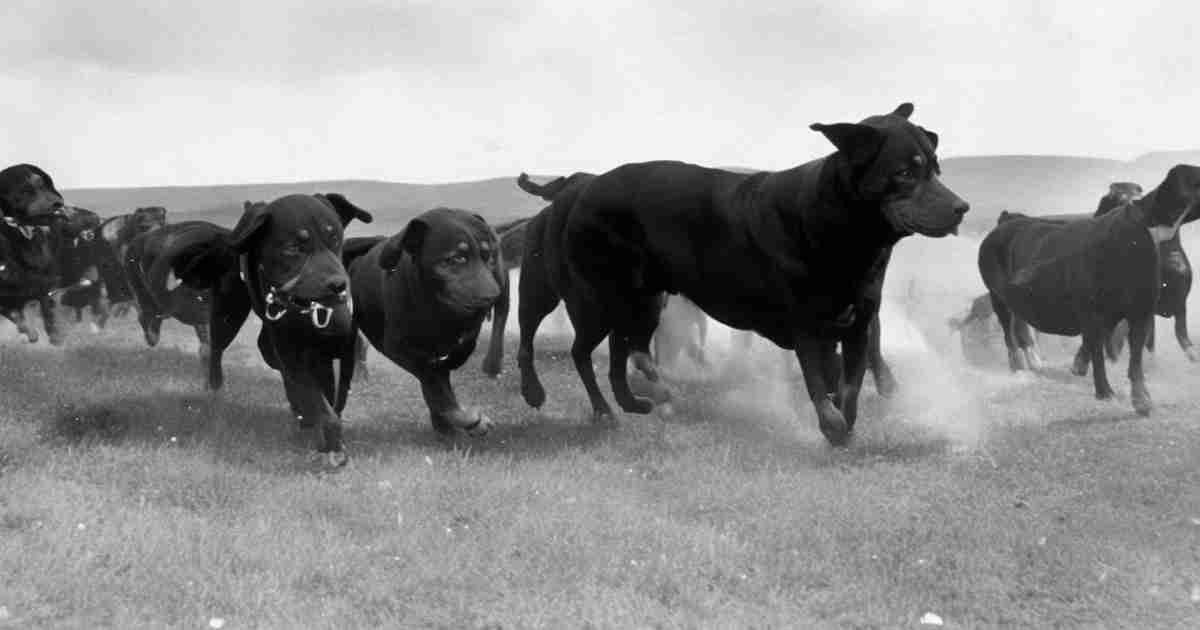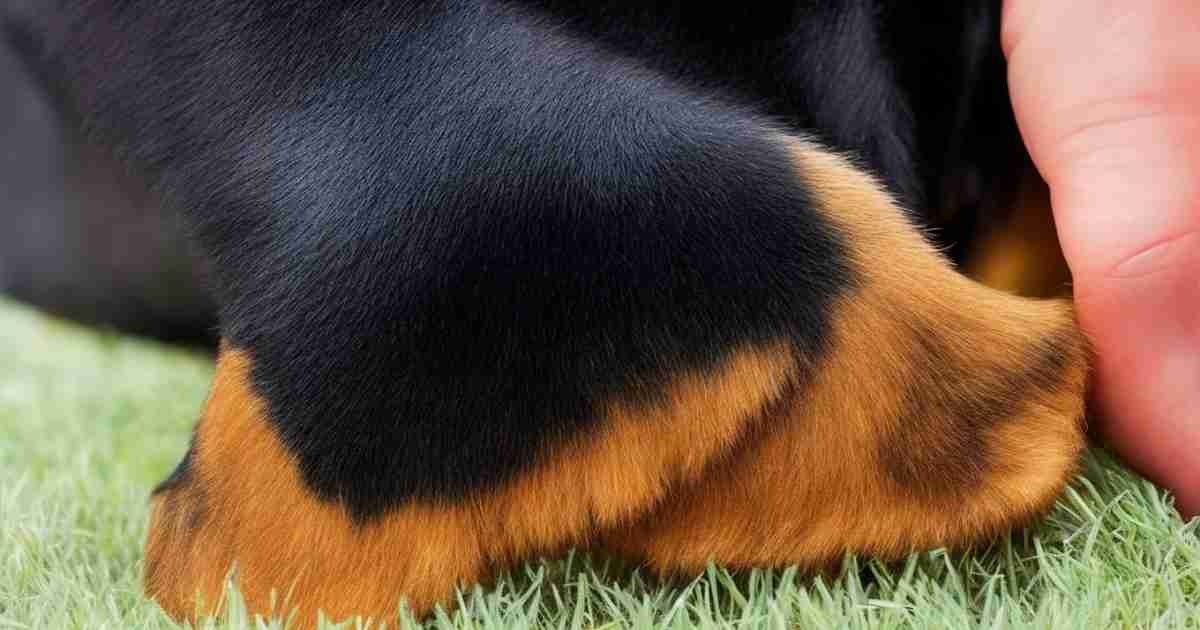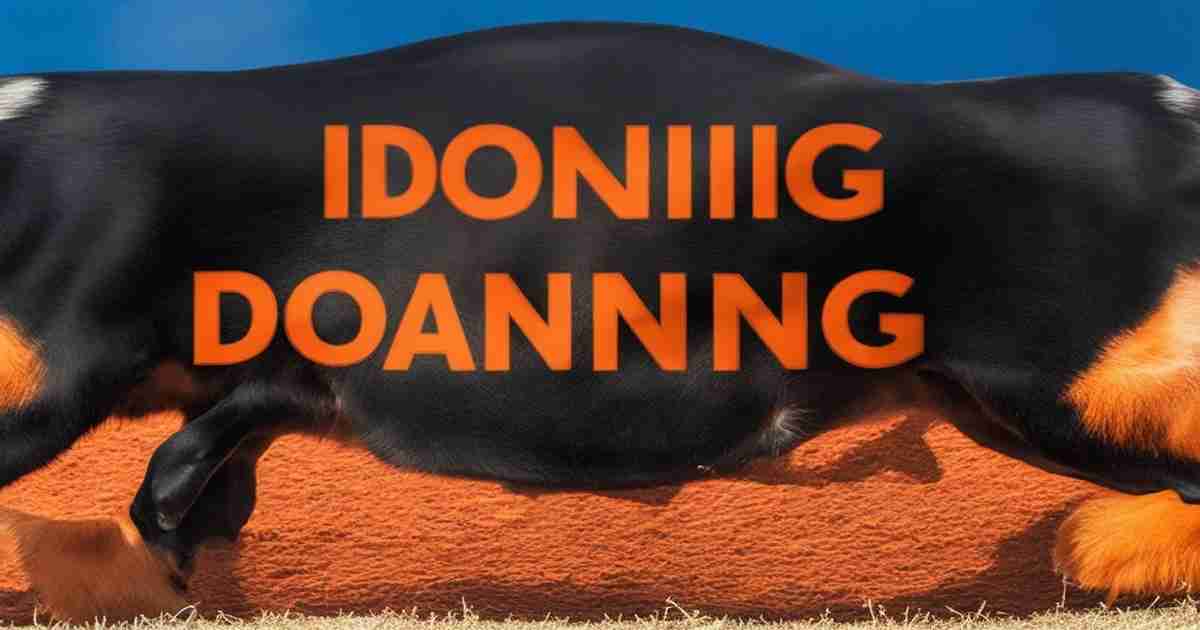Rottweilers, those cherished and adored canine companions renowned for their unwavering devotion, unwavering confidence, and multifaceted adaptability, bring forth a distinct physical feature that distinguishes them significantly from many other canine brethren – their unmistakable, shortened, and surgically altered tail.
Yet, within the realm of Rottweiler tail manipulation, a realm fraught with diverging opinions and a rich tapestry of historical context, one is compelled to ask:
Why do we embark upon this path of tail modification, a journey that invariably kindles contentious discourse?
To navigate this intricate terrain, it is essential to embark on an exploration of the intricate tapestry of Rottweiler tail docking, a practice enshrouded in complexity and ambiguity.
Why, one might ponder, do Rottweiler tails undergo this transformative process known as tail docking?
Tail docking, as a surgical endeavor, entails the amputation of a segment of a dog’s tail, a procedure typically administered during the nascent stages of puppyhood, occurring within the delicate window of 3 to 5 days post-birth.
In the case of Rottweilers, this surgical intervention results in a notably abbreviated tail, rendering it merely a fraction of its original, natural length.
Historically, the practice of tail docking in Rottweilers extends its roots deep into the annals of time, harking back to their origins as a rugged, blue-collar breed originating from the heartlands of Germany.
In days of yore, their roles were varied, including herding and safeguarding cattle, necessitating swift agility and protective instincts.
Proponents of tail docking in the context of Rottweilers posit that this practice once served pragmatic purposes in the lives of these diligent working dogs:
- Preventing Tail Mishaps:Rottweilers, when herding, employed their tails with fervor, a fervor that occasionally led to untoward incidents involving tail-related injuries, a grievous outcome that necessitated the curtailment of tail length to safeguard against harm.
- Shielding Against Frostbite:In regions characterized by frigid winters, a lengthy tail was perceived as susceptible to the biting frost, making tail docking an apparent solution to mitigate the risk of frostbite-related damage.
- Reducing Biting Vulnerability:An argument resonated that a lengthy tail presented an inviting target for the inherently aggressive bovine brethren during herding duties. The docking procedure, therefore, emerged as a defensive measure to avert unnecessary canine injuries stemming from unwarranted bovine aggression.
- Preserving Breed Aesthetics:In the crucible of the 19th-century German breeding for the Rottweiler breed, tail docking found itself etched into the very fabric of the breed’s identity, thereby accentuating its distinct physicality.
Nonetheless, as time flowed inexorably onward, perspectives surrounding these historical justifications began to metamorphose, mirroring the evolving ethos and ethical considerations governing the realm of canine care.
In contemporary times, the primary impetus for subjecting Rottweilers to tail docking orbits around aesthetic pursuits and conformity to entrenched breed standards.
The Contemporary Shift Toward Cosmetic Tail Docking
The world we inhabit today, characterized by the diminished prevalence of Rottweilers partaking in cattle herding, has rendered the specter of tail injuries a relic of the past.
With their diversified roles as companions, exhibition dogs, security personnel, service providers, and more, the incidence of tail-related misadventures has plummeted.
And yet, the practice of tail docking persists, albeit reframed as an instrument for perpetuating the quintessential Rottweiler “visage.”
Proponents of this approach deem a docked tail as an indelible emblem of an authentic Rottweiler, an essential component in encapsulating the breed’s quintessential silhouette.
Nonetheless, an opposing faction decry tail docking for cosmetic purposes, construing it as an unwarranted and agonizing ordeal for these loyal canines.
In the past two decades, particularly, a seismic shift in perspectives has undulated through the canine community.
A mounting recognition of the unwarranted agony and distress inflicted upon puppies during the tail docking process has precipitated a surge of voices advocating for its cessation, deeming it an unjustifiable form of mutilation.
Navigating the Regulatory Landscape
In the global arena, public sentiment has undergone such profound metamorphosis that tail docking has been outright prohibited in over 40 countries, with exceptions granted solely for medical exigencies.
These prohibitive countries include the majority of European Union member states, Australia, and various others.
In the United States, the tides of change unfurl at a more gradual pace, with laws governing tail docking manifesting a patchwork of variance among states.
Some jurisdictions have instituted outright bans on cosmetic docking, while others permit it for select breeds like the Rottweiler, and some maintain a stance of laissez-faire, imposing no restrictions. Nevertheless, the frequency of docking bans surges with each passing year.
Even the venerable American Kennel Club (AKC), an august institution steeped in tradition, has found itself ensnared within the throes of change.
Animal welfare advocates have exerted mounting pressure upon the AKC to expunge docked tails from their breed standards.
Though the AKC has yet to disallow it entirely, they have vocalized their discouragement of the practice for aesthetic reasons.
The Crux of the Controversy
At the nucleus of the ceaseless debate surrounding tail docking looms an ethical quandary of considerable magnitude – is the perpetuation of an idealized standard of appearance a price worth exacting through a procedure that inflicts enduring modification upon these canines? A closer examination of pivotal facets of this dispute is warranted.
The Predicament of Pain
Foremost among the concerns encircling tail docking is the specter of agony visited upon innocent puppies. The tail docking procedure, typically conducted during the initial days of a pup’s existence, unfolds sans the palliative embrace of anesthesia. Consequently, it entails the severance of nerves, bone, and cartilage within this delicate phase of life, an act widely deemed as inhumane by a consortium of veterinary authorities.
Empirical research elucidates the unmistakable behavioral and biochemical indicators of pain and distress emanating from docking. Puppies subjected to this ordeal exhibit signs indicative of acute and chronic suffering, thereby impinging upon their overall welfare.
Nonetheless, proponents of tail docking contend that performing this procedure at such a tender age occasions a diminished degree of suffering, positing that the nascent nervous systems of puppies are ill-equipped to perceive pain in its entirety, with rapid recuperation invariably following the operation.
Yet, the preponderance of evidence converges upon the unequivocal assertion that docking does not unfold devoid of anguish. Accordingly, the consensus within expert circles is that the procedure should be eschewed to obviate the infliction of gratuitous agony.
The Question of Necessity
Another foundational query revolves around the necessity of tail docking for contemporary Rottweilers. As elucidated previously, the vocational roles that once justified this practice have languished into obsolescence within the context of modern canine existence.
In the absence of these pragmatic justifications, the pursuit of preserving the Rottweiler’s aesthetic allure through tail docking is perceived by many as an imposition of human preferences upon dogs.
Detractors argue that the desire to adhere to breed standards, while legitimate, fails to justify the imposition of a painful procedure upon these sentient beings.
In defense of tail docking, proponents assert that it remains indispensable for upholding breed standards and preserving the indelible identity of the Rottweiler.
Nonetheless, critics counter by pointing to other iconic working breeds such as Siberian Huskies and Collies, which continue to flourish with their unaltered, elongated tails. In their view, Rottweilers, too, can retain their distinctive breed attributes with their natural tails intact.
The Erosion of Communicative Capacity
Long tails, as established within the domain of canine biology, occupy an integral role in communication for dogs.
Mirroring the behavioral cues observed in most mammalian species, the tails of dogs serve as conduits through which vital mood indicators are transmitted and decoded by both their fellow canines and their human counterparts.
A vigorously wagging tail, for instance, conveys a message of amiability, while an erect, rigid tail signifies an encroaching sense of unease.
Advocates of tail docking maintain that Rottweilers remain proficient communicators even in the aftermath of tail curtailment.
Nevertheless, studies in canine behavior cast a spotlight upon the subtleties and nuances conveyed through the tails of dogs, suggesting that dogs with their natural tails boast a broader spectrum of emotional expression through their tail movements.
By contrast, the docking procedure attenuates the repertoire of communication, potentially impinging upon their social acumen.
In a breed celebrated for its expressiveness, the diminishment of nuance within their communicative arsenal might, in the estimation of some, exact a toll upon their sociability.
Consequently, a cadre of advocates presently champions the cause of preserving the natural tail length of Rottweilers whenever circumstances permit.
The Enigma of Bobtails
An allied debate ensues surrounding Rottweilers endowed with naturally abbreviated tails, a phenomenon attributed to a specific genetic variant. Diverging from the artificiality of tail docking, bobtailed Rottweilers manifest this trait organically, devoid of human intervention.
Within certain circles of Rottweiler enthusiasts, bobtailed specimens have garnered favor among those seeking to uphold the breed’s customary aesthetics while circumventing the ethical quagmire associated with tail docking.
However, discerning breeders are prone to perceive bobtailed Rottweilers as emblematic of a breed defect, for bobtails arise as capricious mutations, rather than the outcomes of meticulous and purposeful breeding practices.
The Paradigm of Responsible Breeding
This discourse converges with broader issues tethered to responsible breeding practices. Instead of embracing the routine docking of tails, experts urge a pivot toward breeding choices that prioritize the overall well-being of Rottweilers, while concurrently mitigating the risks that necessitate tail amputation.
For instance, certain congenital conditions, such as spinal anomalies, may indeed mandate the surgical excision of a tail as a medical imperative in grave cases.
Nevertheless, selective breeding programs can often ameliorate the incidence of such inherited afflictions, diminishing the need for tail removal.
In summation, the tail docking controversy resists facile resolution, encapsulating the vicissitudes of evolving ethics, burgeoning knowledge, and shifting practices within the realm of canine care.
For extant and prospective Rottweiler custodians, a comprehensive grasp of the manifold perspectives underpinning this contentious issue offers a compass for navigating this pivotal decision.
Contemplating the Fate of an Already Docked Tail
For those entrusted with the guardianship of Rottweilers bearing docked tails, the course is irrevocably charted.
Nonetheless, it remains imperative to familiarize oneself with the historical trajectory and the maelstrom of controversy enshrouding this aspect of your dog’s physicality. Herein lie several salient considerations:
- Absolve Any Sense of Shame:Do not bear the burden of remorse or shame for an extant docked tail. Redirect your focus toward endowing your Rottweiler with a life replete with fulfillment, joy, and purpose.
- Cognizance of Tail Care:Acknowledge the necessity for special care in preserving the hygiene and health of the docked tail. Maintain vigilance against indicators of irritation, infection, or trauma at the site of amputation.
- Decipher Unique Communication:Recognize that a docked tail translates into a limited spectrum of expressive movements. Familiarize yourself with your dog’s distinctive set of signals and cues.
- Prepare for Discourse:Anticipate that individuals in your vicinity may proffer queries or challenges regarding your dog’s altered tail. Some may view it as ethically contentious, prompting thought-provoking conversations. Engage with composure and consideration when such encounters arise.
- Advocate for Change:Should you perceive the need for a shift in the prevailing paradigm surrounding tail docking, consider becoming a part of the effort to engender positive transformations in breed standards and regulatory frameworks. Seek inspiration from ongoing endeavors that advocate change.
- Informed Choices Anew:In the event of future contemplations concerning the acquisition of another Rottweiler, leverage your accrued knowledge to contemplate tail length and breeder practices with prudence. An informed choice invariably stands as the most judicious choice.
The Fateful Decision Surrounding Docking
For those presently responsible for Rottweilers or contemplating the embrace of a Rottweiler into their lives, as the critical decision pertaining to tail docking looms large, several pivotal considerations warrant heed:
- Immerse in Thorough Research:Undertake a comprehensive exploration of the tail docking procedure, delving into its intricacies, and acquaint yourself with the immediate and enduring effects on dogs. Immerse yourself in the expansive ethical discourse that surrounds this practice, thereby engendering an informed decision-making process.
- Legal Landscape Scrutiny:Cast an attentive eye upon the legislative terrain within your geographical confines, for laws governing tail docking oscillate with jurisdiction. Acquaint yourself with the regulations applicable to your locale, distinguishing what is permitted and the constraints imposed.
- Consult Reputable Breeders:Solicit guidance from reputable breeders, individuals endowed with extensive experience and an unwavering commitment to principled breeding practices. Engage in dialogue concerning tail length considerations specific to Rottweilers and the attendant health considerations that bear relevance to your prospective puppy.
- Familiarize with Breed Standards:Peruse and internalize breed standards enforced by canine clubs, as these standards exert a pivotal influence upon the expectations pertaining to tail length within the breed. Engage in discussions concerning whether a docked or natural tail conforms to the exhibition or breeding dog milieu.
- Deliberate Health Implications:Prioritize the well-being of your prospective dog above all else, factoring in their comfort, pain mitigation, health, communicative prowess, and long-term welfare as paramount considerations. Subordinate aesthetic predilections or long-established traditions to the overarching commitment to your dog’s welfare.
With an open mind and a conscientious spirit of contemplation, you can arrive at a judicious decision pertaining to tail docking, one that resonates with your personal values within the sphere of this perennially debated practice.
Rottweilers, resilient and adaptable, thrive with either natural or docked tails when stewarded with care and empathy. As the guardian of these noble creatures, your pursuit remains the provision of what is unequivocally best for your devoted companion.
Conclusion
The contentious practice of tail docking among Rottweilers unfurls as a multifaceted tapestry, marked by complexity, ambiguity, and the unending evolution of perspectives.
This discourse encapsulates the amalgamation of shifting ethical standards, burgeoning knowledge, and fluid practices within the realm of canine care.
Ultimately, in the quest to determine whether to dock or not to dock, it is the responsibility of current and prospective Rottweiler owners to navigate this intricate landscape armed with a comprehensive understanding of the diverse perspectives that envelop this pivotal decision.
Amidst the swirl of the docking controversy, one unassailable truth emerges—responsible ownership and profound respect for these remarkable dogs shall forever reign supreme.
Whether adorned with docked or natural tails, Rottweilers persist as symbols of joy, camaraderie, and boundless companionship for their human kindreds, and it is this profound connection that merits the utmost reverence and consideration.









